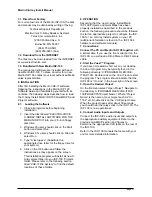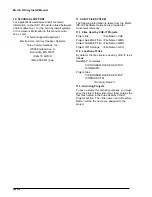
Merlin X-Array Install Manual
page 8
for two purposes. The first is to provide a high-pass
filter for the low-frequency woofer in the full-range
system - which may function as a subsonic filter or
a crossover filter when used with subwoofers. The
second purpose is to provide equalization filters for
tuning the loudspeaker system to the room.
The high-frequency channel contains a five-band
filter, a 0- to 50-ms component offset delay, a 0-to
50-ms look-ahead delay, and a limiter. The
combination of the look-ahead delay and limiter
provides excursion protection and reduction of short
high-level peaks, but does not require side-chain
equalization.
The LF channel contains a five-band filter set
driving an excursion protection circuit. The
excursion protection circuit includes a 0- to 50-ms
look-ahead delay driving a limiter, which is
connected to a 3-band side-chain excursion
emulation filter (see the section on driver excursion
protection for more information).
One of the subwoofer channels contains a two-to-
one combiner to create an optional mono subwoofer
feed. The other sub channel contains a selector to
choose either right or left inputs. Both sub paths
contain a 0- to 650-ms delay, a six-band filter, and
excursion limiting circuit. This filter set is used to
provide an infrasonic high-pass filter, a low-pass
crossover filter, equalization and phase alignment
for the subwoofers.
All outputs of the QuickMAP contain dither blocks to
select the amount of dithering.
CAUTION: As with a conventional digital crossover/
controller, the user may make minor adjustments to
the factory QuickMAP parameters in the audio-path
equalization filters and digital-output levels with
minimal risk to the loudspeaker system. However,
changing parameters in any of the protection-
related blocks from the factory QuickSET values
may result in driver failures. These include the
limiter blocks, the side-chain filter blocks, and the
look-ahead delay blocks.
4.2.
Stereo Three-Way System with Dual
Subwoofers
QuickMAP Name: XI-3WAY.QMS
Figure 6 shows this three-way QuickMAP with all
blocks and their capabilities indicated.
This QuickMAP contains two inputs and eight
outputs divided into a stereo-pair of three-way
processing channels and two identical subwoofer
paths (except for input selection). As with the two-
way systems, the blocks prior to the crossover
include a two-way selector, a 6-band filter set, and a
0- to 1350-ms delay. The filter block prior to the
crossover is used to provide a high-pass filter for
the low-frequency woofer in the full-range system -
which may function as a subsonic filter or a
crossover filter when used with subwoofers, and to
provide equalization filters for tuning the
loudspeaker system to the room.
The low- and mid-frequency channels contain eight-
band filters, while the high-frequency channel
contains a seven-band filter. All output channels
contain broad-band limiters but no specific
excursion protection blocks. The high-frequency
path of each three-way channel also contains a 0-to
50-ms component offset delay and a 0- to 50-ms
look-ahead delay (which provides look ahead
capability for the following limiter). As pointed out
before, the combination of the look-ahead delay
and limiter provides some measure of excursion
protection and also reduces short-term high-level
peaks.
As with the two-way QuickMAP, the sub channels
may also be used as full-range paths. As in the two-
way systems, the filter block in the subwoofer
channel is used to provide a subsonic high-pass
filter, a low-pass crossover filter, equalization and
phase alignment for the subwoofers. As before, one
subwoofer channel contains a two-to-one combiner
for optional mono bass, and the other a selector to
choose either right or left inputs. Both subwoofer
paths also contain a 0 - to - 1350 ms delay block,
and a six-band filter.
CAUTION: When using the three-way systems with
a conventional three-way crossover (i.e., no overlap
between the low and mid sections) the user may
make minor adjustments to the factory QuickMAP
parameters in the audio-path equalization and
digital-output levels in any of the frequency bands
with minimal risk to the loudspeaker system. When
using the three-way systems with the overlap three-
way crossover (i.e., where the low and mid sections
overlap for increased directivity), the user must not
make any changes to any of the factory QuickMAP
parameters (crossover, level, equalization, phase)
in the low and mid channels because it will upset
the acoustic summation in the overlap region. Minor
changes may be made, however, in the parameters
in the audio-path equalization and digital-output
levels in the subwoofer and high channels. In either
the overlap or non-overlap configurations, changing
limiter protection parameters (including limiter block,
and look-ahead delay block) from the factory
QuickSET values may result in driver failures.
4.3.
QuickMAP Timing, System
Synchronization, and Latency
Because of the digital nature of the ISP-100, the
processor contains inherent delays, both fixed and
user adjustable, which must be accounted for in
speaker system and array setup and alignment.
These delays are not only significant for woofer,





































